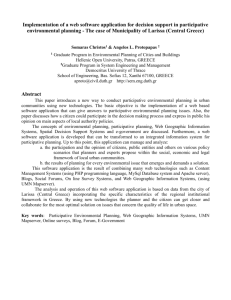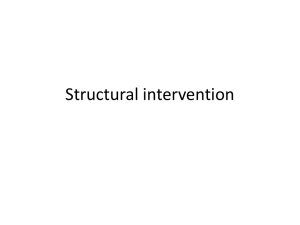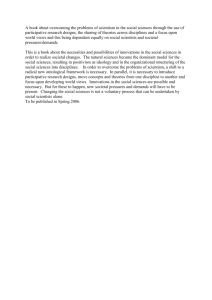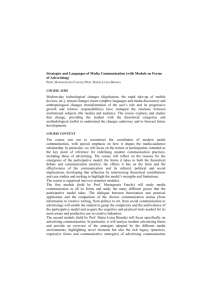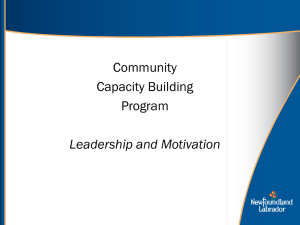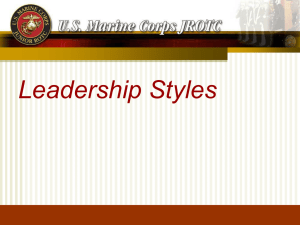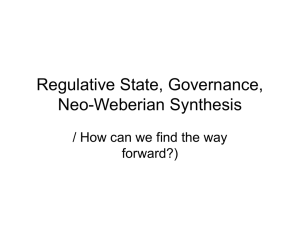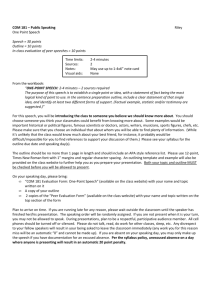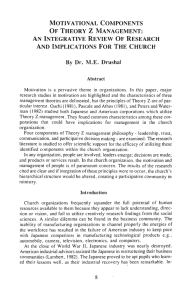How Participative Leadership Powers a Culture of
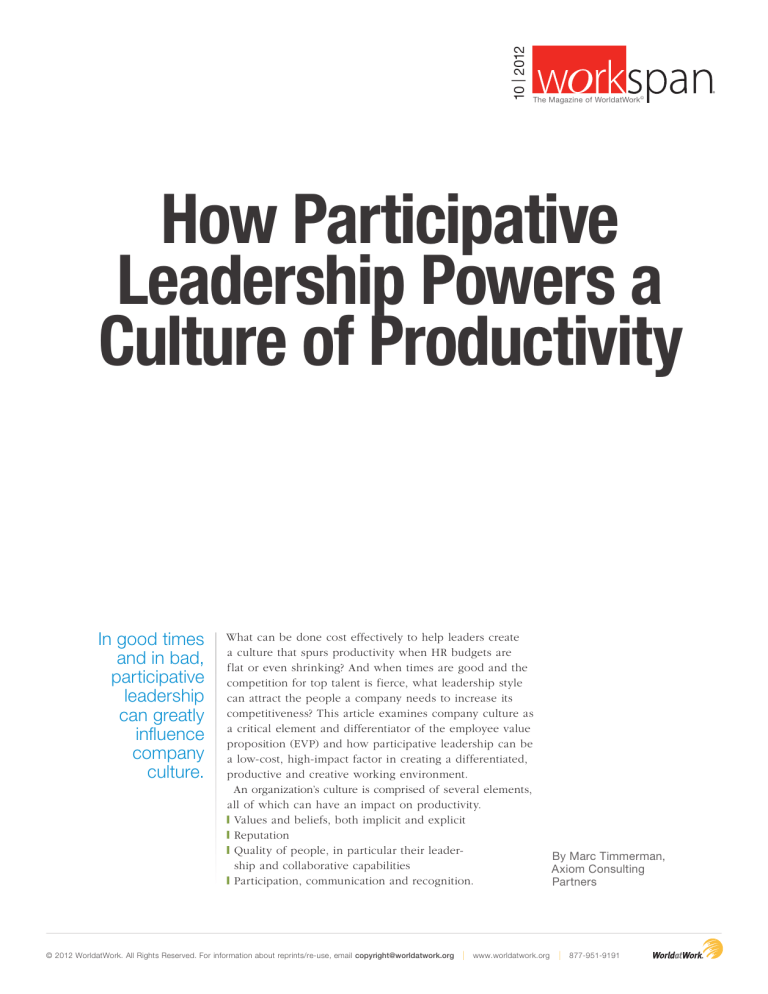
| 2
The Magazine of WorldatWork ©
®
How Participative
Leadership Powers a
Culture of Productivity
In good times and in bad, participative leadership can greatly influence company culture.
What can be done cost effectively to help leaders create a culture that spurs productivity when HR budgets are flat or even shrinking? And when times are good and the competition for top talent is fierce, what leadership style can attract the people a company needs to increase its competitiveness? This article examines company culture as a critical element and differentiator of the employee value proposition (EVP) and how participative leadership can be a low-cost, high-impact factor in creating a differentiated, productive and creative working environment.
An organization’s culture is comprised of several elements, all of which can have an impact on productivity.
Values and beliefs, both implicit and explicit
Reputation
Quality of people, in particular their leadership and collaborative capabilities
Participation, communication and recognition.
By Marc Timmerman,
Axiom Consulting
Partners
© 2012 WorldatWork. All Rights Reserved. For information about reprints/re-use, email copyright@worldatwork.org
| www.worldatwork.org | 877-951-9191
Company Culture
During Austerity
There is plenty of evidence — particularly related to the highpotential employees who are expected to exemplify culture and drive productivity — that demonstrates the debilitating impact of austerity programs. Forced attrition, cutbacks in professional development, the lack of stretch opportunities, and a stagnant business environment create a sense of battle fatigue.
Left unchecked, these attitudes can permeate the entire workforce.
If high-potential employees and rising stars are looking for a way out, there will certainly be a multiplier effect on the people who report to them. A downward spiral of unproductive behavior puts a drag on the organization’s ability to execute its mission.
In times of austerity, most companies can’t afford to add more health benefits, pay bigger bonuses, offer advancement opportunities or lighten the workload. And even when the best companies in the world tried to maintain investing in their rising stars and the future generation of leaders, albeit with heavily reduced budgets, the deal was not the same as it was before the 2007 recession began.
Company Culture During the Good Times
Howard Schultz, the founder of
Starbucks, has said, “You can’t attract and retain great people for a company that isn’t going to grow.” In fact, he has called human capital Starbucks’ biggest growth constraint. During strong economic times participative leadership is appealing to high performers who want to be significant
Figure 1
|
Elements of an Employee Value Proposition
B us in es s
S tra teg y
Benefits
Health care
Retirement
Paid time off
Perquisites
CONTEXT
Career
Career path
Career development
Training
Performance management
Advancement opportunities
Cu sto m ers
Compensation
Base pay
Short-term incentives
Long-term incentives
Premium pay ns itio
EVP
Work Environment ond
Challenge
Autonomy
Performance standards
Work arrangements
(schedule, site, space)
C mic no co E
Culture
Org values/beliefs
Org reputation
Quality of people
(colleagues, leaders, subordinates)
Participation
Communication
Recognition on titi pe om contributors to the company’s success.
Salary and benefits are merely table stakes. The chance to demonstrate their knowledge, interact with senior management and help drive growth is what keeps high performers excited.
A Cost-Effective Alternative
Unfortunately, many organizations haven’t looked at cost-effective alternatives to spur productivity. But based on exchanges with many global leaders in talent management, recent articles and a handful of experiments, the author believes that the culture component of an EVP has the potential to extend temporary loyalty and improve productivity without incurring significant expense.
Applying the principles of participative leadership is one of the best ways to foster a culture that promotes a culture of productivity in good times and bad. Involving others in the decision-making process engages employees on the terms that are important to them and the enterprise — reinforcing their worth to the organization and refocusing their attention on what’s important to business success. Participative leaders are good at listening to subordinates.
Tapping into their expertise in good times can help a leader make better growth-oriented decisions about customer service, pricing, products and markets. In tough times, participative leaders will have the relationships necessary to canvas the front lines for cost-saving ideas across the supply chain.
Participative Leadership in Action
The principles of participative leadership are straightforward:
1 | Engage people in finding solutions to business challenges.
2 | Listen actively to their ideas, concerns and opinions.
3 | Demonstrate empathy.
This is not democratic leadership, and the author is not suggesting that participative leadership is a panacea.
Improving productivity often requires
56
| workspan october 2012
directive leadership; making the unpopular decisions that keep the organization moving in the right direction, but won’t necessarily serve every employee’s self-interest.
The power of participative leadership to affect culture and productivity is well documented in academic literature. For example research shows that:
People perform better in a participative environment (Field and House 1990; Lam, Chen and Schaubroeck 2002).
Groups and teams led by empowering leaders perform better
(Stewart 2006; Wagner 1994).
A participative leadership style improves the innovative behavior of employees (Manz, Bastien,
Hostager and Shapiro 1989; Oldham and Cummings 1996; Tierney,
Farmer and Graen 1999), (Gilson and Shalley 2004; Shipton et al.
2006; West and Anderson 1996).
Group decisions lead to better quality decisions, which are also executed faster (Dionne and Dionne
2008; Hill 1982; Katzenbach and
Smith 2000; Scully, Kirkpatrick and Locke 1995; Nutt 2002;
Williams and Sternberg 1988).
Participation is one of the levers that creates higher employee satisfaction (Brief and Weiss
2002; Grawitch, Block and Ratner
2005; Harter, Schmidt and Hayes
2002; Pritchard et al. 2008).
Participation leads to a higher intrinsic motivation (Ryan and Deci
2000; Van Den Broeck et al. 2008).
Participation leads to a increased feeling of justice and fairness
(Fetchenbauer and Jacobs 2004).
Let’s look at an example of the application of participative leadership.
Many so-called Gen Y rising star employees have a passion for learning from competent leaders. They are aspirational about their career path.
They are looking for ways to demonstrate their worth and seek lots of feedback about their performance.
Leaders should make themselves available to hear what employees have to say. Deploying those principles of engagement, active listening and empathy can spark new ideas and challenge old assumptions.
But just as important, that leadership behavior will demonstrate that the input of rising stars is valued.
Leaders can guide those employees toward a commitment to larger organizational goals by making them part of the strategic discussion. Their intrinsic motivation will be much higher as they see support for their own personal development contributing to the greater good.
HCL Technologies, a $2 billion
IT services company with more than 83,000 employees worldwide, has received accolades from many quarters for its “Employees First,
Customers Second” management philosophy. The aim, said HCL’s
CEO Vineet Nayar, was “To create a unique employee organization, drive an inverted organizational structure, create transparency and accountability within the organization and encourage a value-driven culture.”
Nayar understood that in a service industry it’s the face-to-face interaction between customer and employees where value gets created.
Hence, it is important to empower employees so that they are capable of delivering more value.
Participative leadership is a key component of the HCL approach.
For example, the company uses an annual companywide event to share the leadership’s team vision and strategy. But leadership also responds to questions in interactive sessions and explains how individual contributions fit into the larger organizational framework. Nayar spends two weeks attending local events to personally engage employees.
Technology is a powerful enabler of participative leadership at HCL. The
CEO spends seven hours a week participating in two-way communications via social media. A key feature of this
“U&I” program is that the CEO posts questions in a blog to employees, actively soliciting their feedback and
[HCL’s CEO Vineet]
Nayar understood that in a service industry
it’s the face-to-face interaction between customer and employees where value gets created
,
hence it is important to empower employees so that they are capable of delivering more value.
october 2012 workspan
|
57
When an organization needs to cut its extrinsic rewards and motivational drivers, it needs to make
a bigger appeal to the intrinsic drivers and motivation
of its employees.
ideas. HCL also conducts weekly online polls to gather employee feedback on various issues.
Recognizing that acknowledgement is important to participative leadership, HCL created what it calls
Xtramiles, a rewards and recognition portal that enables timely and instantaneous recognition of employees who have displayed exemplary performance. All employees in the company are eligible for that sort of recognition, and they can learn about the extraordinary accomplishments of others with the click of a mouse.
Have these sorts of programs had an impact on productivity? According to HCL, its employee attrition rate has dropped significantly for nine straight quarters. And its employee usage rate and revenue per employee have measurably increased.
Call to Action
The effect we are witnessing inside many organizations on a global scale during these tough times can be phrased as such: When an organization needs to cut its extrinsic rewards and motivational drivers, it needs to make a bigger appeal to the intrinsic drivers and motivation of its employees. For those employees that have always been treated and nurtured in the best possible way, this appeal needs to be even more strong and clear so the intangible can compensate enough for cuts in tangible rewards and recognition.
If the organization fails to come up with a solid intrinsic alternative and a cultural response, it risks entering into a negative spiral of weakening commitment, dropping productivity rates, a loss of top talent, further loss of loyalty in the employee ranks, further drops in performance and ultimately a threat to the future of the entire enterprise.
Sometimes, management teams can sense that productivity is at risk when a firm’s actions and culture are misaligned. Research into employee attitudes, monitoring and analyzing unforced attrition, and comparing the management styles of different leaders with the data of the exit interviews, can be extremely useful in quantifying the risks and uncovering root causes.
In any case, once the problem of underperforming talent has been identified, one of the most effective ways human resources can help is by promoting the application of new leadership styles.
Help leaders identify opportunities to apply participatory leadership principles. The author contends that 70 percent of the value of professional development initiatives comes from practical assignments that address real business issues.
For rising stars and high potentials, these assignments can re-instill a sense of commitment and purpose.
Teach leaders how to deploy different leadership styles. Research has shown that the No. 1 reason dissatisfied young potentials and high performers leave a company is because of a boss they perceive as incompetent; by that the employees often mean that their boss is not invested in their future. Participative leadership techniques — seeking to listen and understand and then showing empathy by respecting employees’ opinions — are not in every manager’s tool kit. In fact, in times of austerity the tendency may be to default to more autocratic leadership styles.
Re-examine your company’s
EVP and determine if its cultural elements in particular are still aligned with the company’s strategy and financial goals.
Strengthening a company’s culture and increasing a transparent appeal to the intrinsic needs and motivational drivers of its employees will make a positive difference. Making your current leadership teams aware of the positive impact a more participative leadership style can have on the productivity and commitment of their direct reports shows itself to be one of the most effective low-cost, high-impact scenarios through which human resources can contribute to the bottom line.
Marc Timmerman is a partner at Axiom
Consulting Partners in Brussels. He can be reached at mtimmerman@axiomcp.com.
resources plus
For more information, books and education related to this topic, log on to www.worldatwork.org
and use any or all of these keywords:
Employee value proposition
Leadership
Company culture.
58
| workspan october 2012
